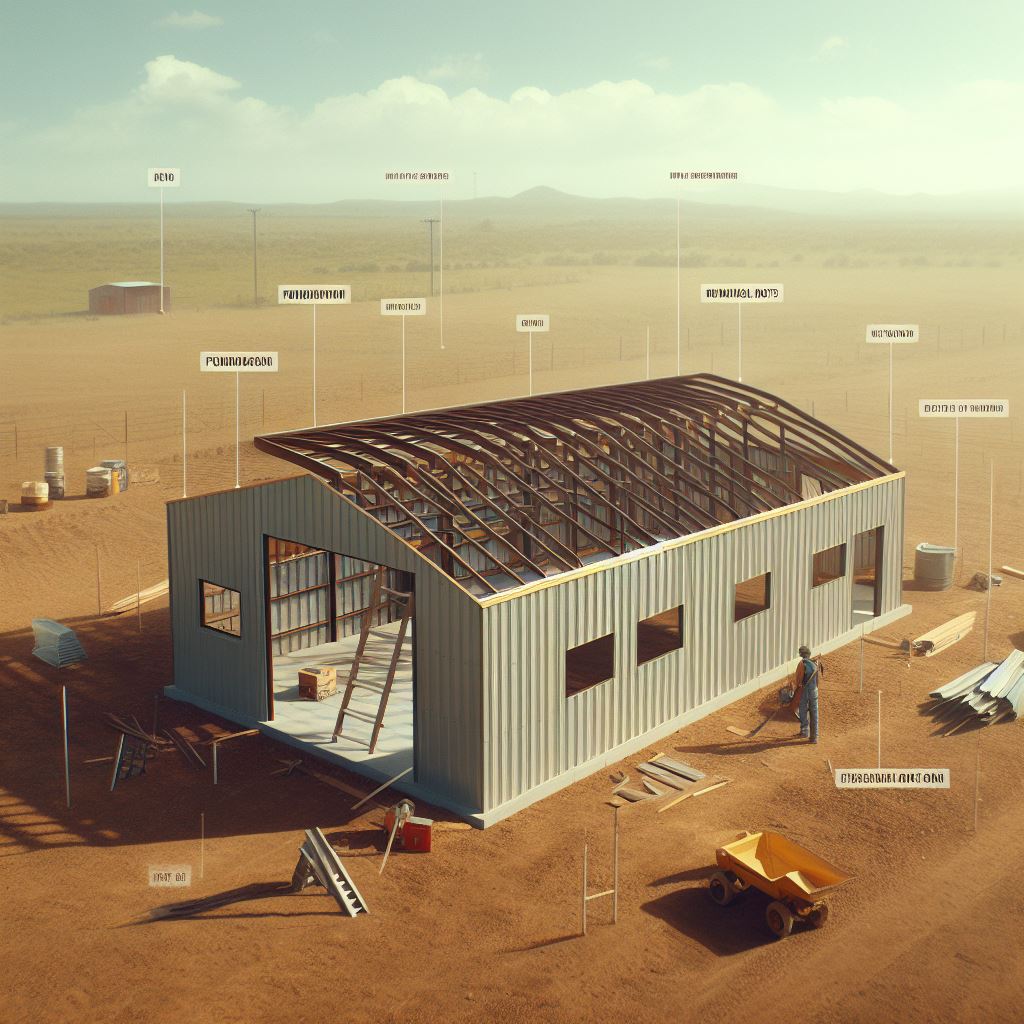How long does it take to install a metal building? By Phillips Industries
Metal building installation refers to the process of assembling and erecting a metal building structure. This includes the construction of the foundation, assembly of the building components, installation of the roof and walls, and the final touches such as doors, windows, electrical and plumbing systems. Proper installation is crucial to ensure the structural integrity and longevity of the building.
Metal buildings have gained popularity in recent years due to their durability, versatility, and cost-effectiveness. They are commonly used for various purposes such as warehouses, industrial facilities, agricultural buildings, and even residential homes. The benefits of metal buildings include their ability to withstand harsh weather conditions, resistance to pests and fire, low maintenance requirements, and quick construction time.
Key Takeaways
- Metal building installation time is affected by various factors such as size, complexity, and weather conditions.
- Pre-installation preparation includes obtaining necessary permits, selecting a suitable location, and ordering materials.
- Site preparation involves clearing the area, leveling the ground, and ensuring proper drainage.
- Foundation construction is crucial for the stability and durability of the metal building.
- Assembly of metal building components, roof and wall installation, and installation of doors and windows require careful attention to detail and proper tools.
Factors that Affect the Installation Time of a Metal Building
Several factors can affect the installation time of a metal building. The size and complexity of the building play a significant role in determining how long it will take to complete the installation. Larger buildings with intricate designs may require more time for assembly compared to smaller, simpler structures.
Weather conditions also play a crucial role in metal building installation. Extreme weather conditions such as heavy rain, strong winds, or extreme temperatures can delay the installation process. It is important to plan the installation during a period of favorable weather to minimize any potential delays.
The availability of labor and equipment is another factor that can affect the installation time. If there is a shortage of skilled labor or if the necessary equipment is not readily available, it can prolong the installation process. It is important to ensure that there is a sufficient number of experienced workers and all the required equipment is on-site before starting the installation.
Site accessibility is also an important factor to consider. If the site is difficult to access or if there are obstacles such as trees or other structures in the way, it can slow down the installation process. It is important to clear the site and ensure that there is easy access for the installation team and their equipment.
Pre-Installation Preparation for a Metal Building
Before starting the metal building installation, there are several important steps that need to be taken to ensure a smooth and successful process. These steps include obtaining necessary permits and approvals, ordering materials and equipment, hiring a professional installation team, and creating a timeline and schedule.
Obtaining necessary permits and approvals is crucial to ensure that the installation complies with local building codes and regulations. It is important to check with the local authorities to determine what permits are required and to obtain them before starting the installation process.
Ordering materials and equipment in advance is essential to avoid any delays during the installation. It is important to work closely with the supplier to ensure that all the necessary materials are ordered and delivered on time. This includes the metal building components, foundation materials, roofing materials, doors, windows, insulation, and any other required items.
Hiring a professional installation team is highly recommended to ensure that the installation is done correctly and efficiently. Professional installers have the necessary skills, experience, and equipment to handle the installation process. They can also provide valuable advice and guidance throughout the project.
Creating a timeline and schedule is important to keep the installation process on track. It helps to set clear deadlines for each phase of the installation and ensures that all tasks are completed in a timely manner. It is important to consider factors such as weather conditions, availability of labor and equipment, and any other potential delays when creating the schedule.
Site Preparation for a Metal Building Installation
Proper site preparation is crucial for a successful metal building installation. This includes clearing and leveling the site, marking the building footprint, installing temporary utilities, and ensuring proper drainage.
Clearing and leveling the site involves removing any vegetation, debris, or obstacles that may be present on the site. This ensures that there is a clean and level surface for the foundation and building components. It is important to clear the site thoroughly to avoid any potential issues during the installation process.
Marking the building footprint is an important step to ensure that the building is positioned correctly on the site. This involves marking the corners and boundaries of the building using stakes and string. It is important to double-check the measurements and ensure that the building is aligned properly before proceeding with the installation.
Installing temporary utilities such as electricity, water, and sanitation facilities is necessary to provide a comfortable working environment for the installation team. This includes setting up temporary power sources, water supply, and portable toilets. It is important to ensure that these utilities are easily accessible and meet the needs of the installation team.
Ensuring proper drainage is crucial to prevent any water accumulation around the building. This includes grading the site to ensure that water flows away from the building, installing drainage systems such as gutters and downspouts, and ensuring that there are no low-lying areas where water can collect. Proper drainage helps to protect the foundation and prevent any potential water damage.
Foundation Construction for a Metal Building
The foundation is a critical component of a metal building as it provides stability and support for the entire structure. There are several types of foundations that can be used for metal buildings, including concrete slab, pier and beam, and concrete piers.
The most common type of foundation for metal buildings is a concrete slab. This involves pouring a thick layer of concrete directly onto the prepared site. The concrete needs to be properly cured before proceeding with the installation of the building components. The curing time can vary depending on factors such as weather conditions and the type of concrete used.
Anchor bolt placement is an important step in foundation construction. Anchor bolts are embedded in the concrete slab and serve as attachment points for the metal building components. It is important to ensure that the anchor bolts are placed correctly and securely to provide a strong connection between the foundation and the building.
Checking for level and square is crucial to ensure that the foundation is properly constructed. This involves using a level and measuring tape to ensure that the foundation is level and the corners are square. Any discrepancies should be addressed before proceeding with the installation of the building components.
Assembly of Metal Building Components

Once the foundation is complete, the next step is to assemble the metal building components. This includes sorting and organizing the components, erecting the main frame, installing secondary framing, and attaching sheeting and insulation.
Sorting and organizing the components is an important step to ensure that everything is in order before starting the assembly process. This involves checking the inventory, identifying each component, and organizing them according to their size and type. It is important to have a clear understanding of the assembly instructions and ensure that all the necessary components are available.
Erecting the main frame is a critical step in metal building installation. This involves lifting and securing the main columns and rafters into position. It is important to follow the manufacturer’s instructions carefully and use proper lifting equipment to ensure a safe and accurate installation.
Installing secondary framing involves attaching purlins, girts, and bracing to provide additional support for the building. This includes aligning and securing these components according to the manufacturer’s instructions. It is important to ensure that all connections are tight and secure to maintain the structural integrity of the building.
Attaching sheeting and insulation is the final step in assembling the metal building components. This involves installing roof panels, wall panels, trim, and insulation according to the manufacturer’s instructions. It is important to ensure that all panels are properly aligned, fastened securely, and sealed to provide a weatherproof and energy-efficient building.
Roof and Wall to Install a Metal Building
The installation of the roof and walls is a crucial step in completing a metal building. This includes installing roof panels and trim, installing wall panels and trim, and sealing and weatherproofing.
Installing roof panels and trim involves placing the panels on the roof frame and securing them with screws or other fasteners. It is important to follow the manufacturer’s instructions and ensure that the panels are properly aligned and fastened. Trim is then installed to provide a finished look and to seal any gaps between the panels.
Installing wall panels and trim follows a similar process as the roof installation. The panels are placed on the wall frame and secured with screws or other fasteners. Trim is then installed to provide a finished look and to seal any gaps between the panels. It is important to ensure that all panels are properly aligned, fastened securely, and sealed to provide a weatherproof and aesthetically pleasing building.
Sealing and weatherproofing is an important step in metal building installation. This involves applying sealants, caulking, or other weatherproofing materials to ensure that there are no leaks or gaps in the building envelope. It is important to pay attention to areas such as roof penetrations, wall joints, and openings for doors and windows.
Installation of Doors and Windows on a Metal Building
The installation of doors and windows is an important step in completing a metal building. This includes choosing the right doors and windows, framing and installing openings, and installing the doors and windows.
Choosing the right doors and windows is crucial to ensure that they meet the specific needs of the building. This includes considering factors such as size, style, functionality, security, and energy efficiency. It is important to work closely with a supplier or manufacturer to select the most suitable doors and windows for the building.
Framing and installing openings involves creating openings in the walls or roof for the doors and windows. This includes measuring and marking the locations of the openings, cutting through the metal panels, and framing the openings with appropriate materials such as steel or wood. It is important to ensure that the openings are properly framed and aligned before proceeding with the installation.
Installing doors and windows follows a similar process as the installation of other building components. This involves placing the doors and windows in the openings, securing them with screws or other fasteners, and ensuring that they are properly sealed and weatherproofed. It is important to follow the manufacturer’s instructions and ensure that the doors and windows are installed correctly and securely.
Electrical and Plumbing Installation for a Metal Building
The installation of electrical and plumbing systems is an important step in completing a metal building. This includes planning the systems, running wiring and piping, and installing fixtures and outlets.
Planning electrical and plumbing systems involves determining the specific needs of the building and designing the systems accordingly. This includes considering factors such as the size of the building, the number of rooms or areas, the intended use of each area, and any specific requirements or regulations. It is important to work with a professional electrician and plumber to ensure that the systems are designed correctly.
Running wiring and piping involves installing electrical wires, cables, and conduits, as well as water supply lines, drainage pipes, and ventilation ducts. This includes routing the wiring and piping through walls, ceilings, or floors, and connecting them to appropriate fixtures or outlets. It is important to follow electrical and plumbing codes and regulations to ensure that the systems are installed safely and correctly.
Installing fixtures and outlets involves placing light fixtures, switches, outlets, sinks, toilets, showers, or any other required fixtures in their designated locations. This includes connecting them to the electrical or plumbing systems and ensuring that they are properly secured and functional. It is important to test all fixtures and outlets to ensure that they are working correctly before completing the installation.
Final Inspection and Completion of a Metal Building Installation
Once all the components of the metal building have been installed, a final inspection is conducted to ensure that everything is in order and meets the required standards. This includes checking the structural integrity of the building, inspecting the electrical and plumbing systems, and addressing any issues or concerns.
Conducting a final inspection involves visually inspecting the building from both the interior and exterior to ensure that there are no visible defects or damages. It also involves checking the alignment, levelness, and squareness of the building components. Any issues or concerns that are identified during the inspection should be addressed and resolved before completing the installation.
Addressing any issues or concerns may involve making necessary repairs or adjustments to ensure that the building is safe, functional, and aesthetically pleasing. This may include fixing any leaks, replacing damaged components, adjusting doors or windows, or addressing any electrical or plumbing issues. It is important to work closely with a professional contractor or installer to address these issues properly.
Obtaining final approvals and permits is necessary to ensure that the installation complies with all applicable regulations and standards. This includes obtaining a final inspection report and any necessary certificates or documents. It is important to keep a record of all inspections, approvals, and permits for future reference.
Handing over the completed building to the owner is the final step in metal building installation. This involves providing the owner with all relevant documents, warranties, and maintenance instructions. It is important to ensure that the owner is satisfied with the completed building and has all the necessary information to maintain and operate it properly.
Proper metal building installation is crucial to ensure the structural integrity, durability, and longevity of the building. It involves several steps including pre-installation preparation, site preparation, foundation construction, assembly of components, roof and wall installation, installation of doors and windows, electrical and plumbing installation, and a final inspection.
To ensure a successful installation, it is important to consider factors such as size and complexity of the building, weather conditions, availability of labor and equipment, and site accessibility. Proper pre-installation preparation, including obtaining necessary permits and approvals, ordering materials and equipment, hiring a professional installation team, and creating a timeline and schedule, is also crucial.
I t is recommended to seek professional help for metal building installation to ensure that the process is done correctly and efficiently. Professional installers have the necessary skills, experience, and equipment to handle the installation process. They can also provide valuable advice and guidance throughout the project. By following these guidelines and seeking professional help, one can ensure a successful metal building installation.
t is recommended to seek professional help for metal building installation to ensure that the process is done correctly and efficiently. Professional installers have the necessary skills, experience, and equipment to handle the installation process. They can also provide valuable advice and guidance throughout the project. By following these guidelines and seeking professional help, one can ensure a successful metal building installation.
If you’re interested in learning more about the construction industry in Texas, Phillips Industries has a range of related articles that you might find helpful. For example, they have an informative article on their website about hiring a masonry contractor in Texas. This article provides insights into the benefits of working with a professional masonry contractor and offers tips for finding the right one for your project. To read more about it, check out Masonry Contractor in Texas. Additionally, if you’re looking for information on framing contractors or fence contractors in Texas, Phillips Industries has dedicated articles on those topics as well. You can find them at Framing Contractor in Texas and Fence Contractor in Texas respectively.
Visit Our other Services
House Painter in Texas | Electrical Contractor in Texas | Metal Shed Contractor in Texas | Drywall Contractor in Texas
FAQs

What is a metal building?
A metal building is a structure made of steel or metal components that are designed to provide a durable and cost-effective solution for various construction needs.
What are the benefits of a metal building?
Metal buildings offer several benefits, including durability, affordability, versatility, and energy efficiency. They are also easy to maintain and can be customized to meet specific design requirements.
How long does it take to install a metal building?
The installation time for a metal building can vary depending on several factors, such as the size and complexity of the structure, the weather conditions, and the availability of labor. However, on average, it takes about 2-4 weeks to install a metal building.
What is the installation process for a metal building?
The installation process for a metal building typically involves several steps, including site preparation, foundation construction, framing, roofing, and finishing. The process may also involve the installation of insulation, electrical and plumbing systems, and other components.
What factors can affect the installation time for a metal building?
Several factors can affect the installation time for a metal building, including the size and complexity of the structure, the weather conditions, the availability of labor, and the type of foundation required. Other factors may include the need for additional customization or modifications to the design.
Can I install a metal building myself?
While it is possible to install a metal building yourself, it is generally recommended to hire a professional contractor with experience in metal building installation. This can help ensure that the structure is installed correctly and meets all safety and building code requirements.
Page Design by: Website Creators Near Me






